Redefining Contributions: Shapley-Driven Federated Learning
Nurbek Tastan Samar Fares Toluwani Aremu
Samuel Horvath Karthik Nandakumar
Abstract
Federated learning (FL) has emerged as a pivotal approach in machine learning, enabling multiple participants to collaboratively train a global model without sharing raw data. While FL finds applications in various domains such as healthcare and finance, it is challenging to ensure global model convergence when participants do not contribute equally and/or honestly. To overcome this challenge, principled mechanisms are required to evaluate the contributions made by individual participants in the FL setting. Existing solutions for contribution assessment rely on general accuracy evaluation, often failing to capture nuanced dynamics and class-specific influences. This paper proposes a novel contribution assessment method called ShapFed for fine-grained evaluation of participant contributions in FL. Our approach uses Shapley values from cooperative game theory to provide a granular understanding of class-specific influences. Based on ShapFed, we introduce a weighted aggregation method called ShapFed-WA, which outperforms conventional federated averaging, especially in class-imbalanced scenarios. Personalizing participant updates based on their contributions further enhances collaborative fairness by delivering differentiated models commensurate with the participant contributions. Experiments on CIFAR-10, Chest X-Ray, and Fed-ISIC2019 datasets demonstrate the effectiveness of our approach in improving utility, efficiency, and fairness in FL systems.

ShapFed - Main Algorithm
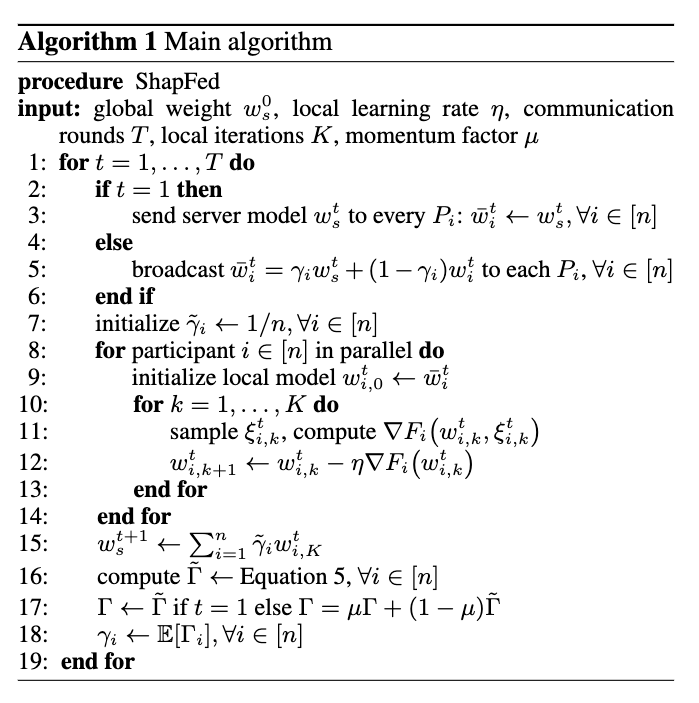

Results: Contribution Assessment
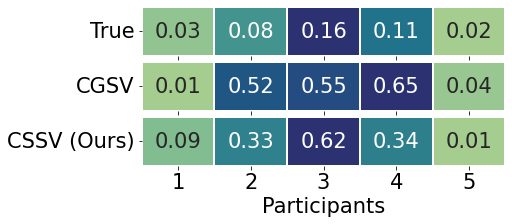
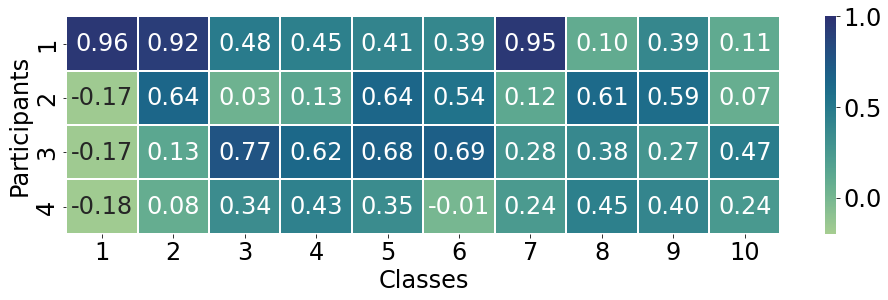
Results: Weighted Aggregation
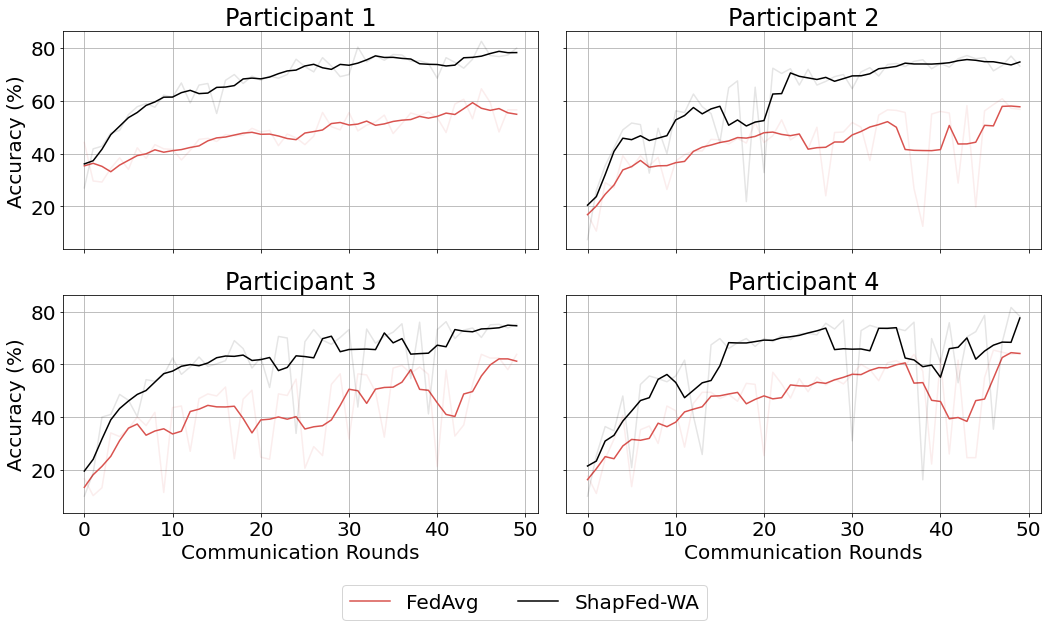
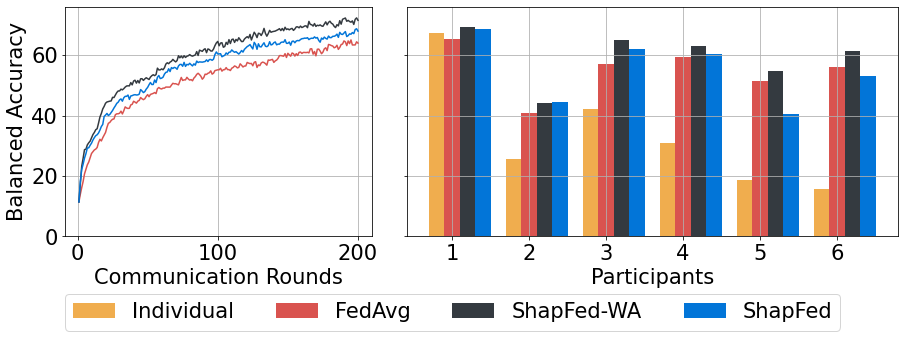
Results: Personalization
| Dataset / Partition | Setting | \(P_1\) | \(P_2\) | \(P_3\) | \(P_4\) | \(P_5\) | Corr. | |
|---|---|---|---|---|---|---|---|---|
| ChestXRay | Hetero. | Individual | 50.0 | 64.7 | 62.0 | 53.7 | 50.0 | --- |
| FedAvg | 50.0 | 55.8 | 61.9 | 54.2 | 50.0 | 0.82 | ||
| ShapFed | 50.0 | 65.2 | 69.5 | 58.5 | 50.0 | 0.93 | ||
| CIFAR-10 | Imb. | Individual | 75.8 | 45.4 | 48.6 | 31.6 | --- | --- |
| FedAvg | 56.6 | 56.8 | 63.8 | 64.2 | --- | -0.60 | ||
| CGSV | 57.2 | 59.0 | 58.8 | 60.4 | --- | -0.98 | ||
| ShapFed | 81.4 | 78.2 | 71.8 | 73.6 | --- | 0.74 | ||
| Hetero. | Individual | 75.2 | 68.8 | 66.8 | 69.0 | --- | --- | |
| FedAvg | 74.6 | 70.2 | 70.2 | 76.0 | --- | 0.53 | ||
| CGSV | 55.0 | 55.8 | 57.2 | 52.6 | --- | -0.26 | ||
| ShapFed | 79.8 | 75.4 | 69.0 | 75.0 | --- | 0.90 | ||
| Note: Correlation coefficients indicate the fairness level, with higher values showing better fairness. | ||||||||
| Setting | \(P_1\) | \(P_2\) | \(P_3\) | \(P_4\) | \(P_5\) | \(P_6\) | Corr. |
|---|---|---|---|---|---|---|---|
| Individual | 67.2 | 25.7 | 42.3 | 31.0 | 18.5 | 15.6 | --- |
| FedAvg | 65.4 | 40.9 | 57.2 | 59.3 | 51.5 | 56.2 | 0.63 |
| ShapFed-WA | 69.3 | 44.3 | 65.0 | 63.1 | 54.8 | 61.2 | 0.62 |
| ShapFed | 68.5 | 44.4 | 61.9 | 60.4 | 40.6 | 53.2 | 0.84 |
Summary
This work proposes Class-Specific Shapley Values (CSSVs) to quantify participant contributions at a granular level. The contributions of this work include a novel method to deepen the understanding of participant impact and improve fairness analysis. Evaluation against FedAvg shows superior performance and additional experiments reveal enhanced fairness by personalizing client updates based on contributions. Overall, the approach aims to achieve a more equitable distribution of benefits in FL. In future, we plan to conduct an in-depth theoretical analysis aimed at identifying the specific characteristics that contribute to an effective estimation of Shapley values. This analysis will enhance our understanding of the factors that influence the accuracy and reliability of Shapley value approximations. Furthermore, an investigation into what makes our approximation of cosine similarity from the last layer a robust indicator of contributions will be explored.
Contact
Contact me at nurbek [dot] tastan [at] mbzuai [dot] ac [dot] ae.
Citation
@InProceedings{tastan2024redefining,
author = {Tastan, Nurbek and Fares, Samar and Aremu, Toluwani and Horvath, Samuel and Nandakumar, Karthik},
title = {Redefining Contributions: Shapley-Driven Federated Learning},
booktitle = {International Joint Conference on Artificial Intelligence (IJCAI)},
year = {2024},
}